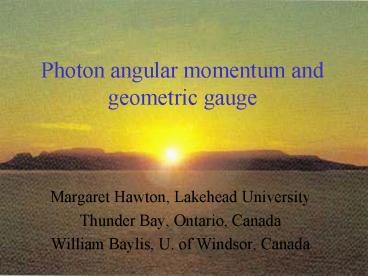Photon angular momentum and geometric gauge PowerPoint PPT Presentation
Title: Photon angular momentum and geometric gauge
1
Photon angular momentum and geometric gauge
- Margaret Hawton, Lakehead University
- Thunder Bay, Ontario, Canada
- William Baylis, U. of Windsor, Canada
2
Outline
- photon r operators and their localized
eigenvectors - leads to transverse bases and geometric gauge
transformations, - then to orbital angular momentum of the bases,
connection with optical beams - conclude
3
Notation momentum space
4
Is the position of the photon an observable?
In quantum mechanics, any observable requires a
Hermitian operator
- a 1/2 for FEicB p1/2 as in QED to
normalize - last term maintains transversality of rP(F)
- but the components of rP dont commute!
- thus the photon is not localizable?
5
A photon is asymptotically localizable
6
- Is there a photon position operator with
commuting components and exactly localized
eigenvectors? - It has been claimed that since the early day of
quantum mechanics that there is not. - Surprisingly, we found a family of r operators,
- Hawton, Phys. Rev. A 59, 954 (1999).
- Hawton and Baylis, Phys. Rev. A 64,
012101 (2001). - and, not surprisingly, some are sceptical!
7
Euler angles of basis
8
New position operator becomes
- its components commute
- eigenvectors are exactly localized states
- it depends on geometric gauge, c, that is on
choice of transverse basis
9
Like a gauge transformation in EM
10
Topology You cant comb the hair on a fuzz ball
without creating a screw dislocation.
Phase discontinuity at origin gives d-function
string when differentiated.
11
Geometric gauge transformation
no z singularity
12
(No Transcript)
13
Is the physics c-dependent?
Localized basis states depend on choice of c,
e.g. el(0) or el(-f) localized eigenvectors look
physically different in terms of their
vortices. This has been given as a reason that
our position operator may be invalid. The
resolution lies in understanding the role of
angular momentum (AM). Note orbital AM rxp
involves photon position.
14
Wave function, e.g. FEicB
Any field can be expanded in plane wave using the
transverse basis determined by c
f(p) will be called the (expansion) coefficient.
For F describing a specific physical state,
change of el(c) must be compensated by change in
f.
15
Optical angular momentum (AM)
16
Interpretation for helicity l1, single valued,
dislocation on -ve z-axis
sz1, lz 0
sz -1, lz 2
sz0, lz 1
Basis has uncertain spin and orbital AM, definite
jz1.
17
Position space
18
Beams
Any Fourier expansion of the fields must make use
of some transverse basis to write and the theory
of geometric gauge transformations presented so
far in the context of exactly localized states
applies - in particular it applies to optical
beams. Some examples involving beams follow
19
The basis vectors contribute orbital AM.
20
Elimination of e2if term requires linear
combination of RH and LH helicity basis states.
21
Partition of J between basis and coefficient
Dc to rotate axis is also possible, but
inconvenient.
22
Commutation relations
L(c) is a true angular momentum. Confirms that
localized photon has a definite z-component of
total angular momentum.
23
Summary
- Localized photon states have orbital AM and
integral total AM, jz, in any chosen direction. - These photons are not just fuzzy balls, they
contain a screw phase dislocation. - A geometric gauge transformation redistributes
orbital AM between basis and coefficient, but
leave jz invariant. - These considerations apply quite generally, e.g.
to optical beam AM. Position and orbital AM
related through Lrxp.

